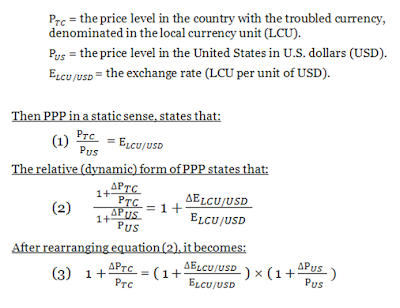Research by Professor Steve H. Hanke, Professor of Applied Economics at John Hopkins University and Senior Fellow at the Cato Institute gives us a fascinating look at the world's troubled currencies. This is particularly pertinent with both Egypt and Syria experiencing internally driven (and, in the case of Syria, the potential for externally driven) conflict. Currency valuation changes can be directly linked to domestic inflation rates with troubled currencies usually leading to elevated rates of inflation.
To open, we need to understand how Dr. Hanke calculates implied inflation. He notes that official government inflation statistics are rarely reported in a timely fashion and that they are generally either deceptive or completely fabricated. Using the free market exchange rate (also known as the black market exchange rate) rather than the official central bank exchange rate, one can quite easily calculate reliable inflation estimates during periods when inflation is growing at a very high rate. The principle of "purchasing power parity" or PPP links changes in price to changes in exchange rates since PPP states that the exchange rate between two countries is equivalent to the ratio of their relative price levels. in other words, the exchange rate between two currencies are in equilibrium when their purchasing power is the same in each of the two countries. For example, if the exchange rate between Canada and the United States is $1.50 CAD to $1 USD, a consumer item that costs $750 in Canada should cost $500 in the United States. This concept only works when there is no interference from government through the imposition of duties or other barriers to trade and only applies to goods that are mobile (i.e. not real estate).
Once we know the inflation rate in the United States and the black market exchange rate for the local currency, we can calculate the rate of implied inflation using the following equations:
Now, let's look at the impact of the current internal fighting on Syria's currency, the pound, and on its inflation rate. Here is a graph showing the fall in the value of the Syrian pound to the U.S. dollar on the nation's black market (in blue) and the official exchange rate (in red):
In the winter and spring of 2012, on Syria's black market, one would pay between 75 and 90 Syrian pounds to buy a U.S. dollar. Currently, one would pay about 270 Syrian pounds to buy a U.S. dollar, a drop of 260 percent. In two days alone, the Syrian pound lost 24 percent of its value against the U.S. dollar after John Kerry announced the possibility of United States involvement in the crisis.
This is what has happened to Syria's annual inflation rate as a result noting that the implied inflation rate is calculated from the movements in the black market Syrian pound/U.S. dollar exchange rate:
The current annual official inflation rate in Syria, according to Syrian authorities was 40.23 percent in May 2013. According to the aforementioned calculation of implied inflation using PPP, Syria's implied annual inflation rate is a whopping 291.88 percent.
While we keep reading about the physical suffering in Syria, the economic pressures of living in a troubled country are quite clearly adding insult to injury for its civilian population.
Click HERE to read more of Glen Asher's columns
You can publish this article on your website as long as you provide a link back to this page.




Be the first to comment